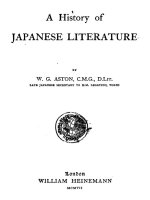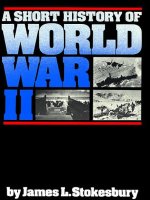Tony judt postwar a history of europe s 945 (v5 0)
Bạn đang xem bản rút gọn của tài liệu. Xem và tải ngay bản đầy đủ của tài liệu tại đây (5.57 MB, 805 trang )
Table of Contents
ABOUT THE AUTHOR
Title Page
Copyright Page
Dedication
Preface & Acknowledgements
Introduction
PART ONE - Post-War: 1945-1953
I - The Legacy of War
II - Retribution
III - The Rehabilitation of Europe
IV - The Impossible Settlement
V - The Coming of the Cold War
VI - Into the Whirlwind
VII - Culture Wars
CODA - The End of Old Europe
PART TWO - Prosperity and Its Discontents: 1953-1971
VIII - The Politics of Stability
IX - Lost Illusions
X - The Age of Affluence
POSTSCRIPT: - A Tale of Two Economies
XI - The Social Democratic Moment
XII - The Spectre of Revolution
XIII - The End of the Affair
PART THREE - Recessional: 1971-1989
XIV - Diminished Expectations
XV - Politics in a New Key
XVI - A Time of Transition
XVII - The New Realism
XVIII - The Power of the Powerless
XIX - The End of the Old Order
PART FOUR - After the Fall: 1989-2005
XX - A Fissile Continent
XXI - The Reckoning
XXII - The Old Europe—and the New
XXIII - The Varieties of Europe
XXIV - Europe as a Way of Life
Photo Credits
Suggestions for Further Reading
Praise for Tony Judt’s Postwar
“If anyone can bring off the impossible task that Tony Judt has set himself in Postwar, it is he. . . . He
brings to Postwar an astonishing range of knowledge and an intense political, intellectual and
emotional engagement; these are nicely offset by the intellectual distance that the Channel and the
Atlantic have helped to provide and by a wry sense of the innumerable ways in which events play
tricks on all of us. The result is a book that has the pace of a thriller and the scope of an encyclopedia;
it is a very considerable achievement. . . . Brilliant.”—The New York Review of Books
“Postwar is a remarkable book. . . . The excellence of Postwar was no doubt hard to achieve . . . but
it is easy to describe. The writing is vivid; the coverage—of little countries as well as of great ones
—is virtually superhuman; and, above all, the book is smart. Every page contains unexpected data, or
a fresh observation, or a familiar observation freshly turned.”
—Louis Menand, The New Yorker
“Massive, kaleidoscopic and thoroughly readable . . . [Judt’s] book becomes the definitive account of
Europe’s rise from the ashes and its take-off into an uncertain future.”—Time (One of the Must-Read
Books of 2005)
“Tony Judt is one of our most dazzling public intellectuals, as thoughtful as he is knowledgeable.
Postwar is like having an extended personal seminar on Europe’s journey back both from the ashes of
World War Two and the cruel, totalitarian hold of Soviet communism.”—David Halberstam
“Nobody is more qualified than Judt to combine serious descriptive history with incisive, original
political analysis, to cover both western and eastern Europe, and to pass stinging yet informed
judgments on the behavior and evasions, the deeds and the failings, of his subjects. . . . This
monumental work is a tour-de-force.”—Foreign Affairs
“Professor Judt knows more about contemporary Europe than almost any American (or any European,
for that matter). In Postwar, he brings that formidable knowledge to bear on the inspiring story of
Europe’s transformation from lethal division and devastating war to a peaceful, prosperous pancontinental union. His history of how the Iron Curtain crumbled is definitive.”—T. R. Reid, author of
The United States of Europe
“An epically important subject—Europe as both the epicenter of political and ideological
catastrophes in the last century and the principal laboratory for an experiment in whatever chance
humanity has of a peace in the century just begun—has, to the benefit of us all, found the author it
deserves. Tony Judt, long one of the wisest heads and clearest voices around, has produced a
magisterial history and a solid foundation for clear thinking about the future. Postwar is meticulous in
its scholarship, compelling in the story it tells, and passionate in its judgments. A true masterpiece.”
—Strobe Talbott, president, Brookings Institution
“Truly superb. It is hard to imagine how a better—and more readable—history of the emergence of
today’s Europe from the ashes of 1945 could ever be written.”—Ian Kershaw
“Magisterial . . . He has written a magnificent conventional history of modern Europe, but its quality
and its power come from the way he insists that his narrative is also a history of ideas and of the
peculiar vulnerability of the European mind to ideologies and to the patterns of thought and political
loyalty they impose.”—National Affairs
“As soon as you realize how good it is, this book will frighten you. . . . This is a work which, on
almost every page, evokes to readers over the age of forty what they once felt, hoped for, took part in,
or fled from. Judt has written, in great detail and at great length, the biography of a middle-aged
continent trying, after a disgraceful past, to settle down and go straight.”
—Neal Acherson, London Review of Books
“Rich and immensely detailed.”—The New York Times Book Review
“Tony Judt . . . has produced not only the heaviest history of modern Europe ever written, but
probably the best. . . . [He] moves fluently and deftly from politics and economics to films and
television, whisking the reader through West German coalition-building, past the French New Wave,
and on toward the Eurovision Song Contest. . . . [A] magnificently rich and readable book.”—The
Sunday Times (London)
“Masterly and exhilarating . . . Judt has made the ‘culture wars’ between communism and
anticommunism a special subject and he deals with this brilliantly once more. . . . Judt has a fine eye
for telling detail. . . . This is a splendid book to which no review can do proper justice. So many
subjects are adroitly dealt with.”—Geoffrey Wheatcroft, The Spectator
“This is the best history we have of Europe in the postwar period and not likely to be surpassed for
many years. . . . Here [Judt] combines deep knowledge with a sharply honed style and an eye for the
expressive detail. . . . Insightful analysis and excellent writing . . . overall, this is history writing at its
very best.”—Publishers Weekly (starred review)
“[A] lively and thoughtful historical overview of today’s Europe from the end of World War II
through the economic, social, cultural and political changes and continuities of the last sixty years. . . .
Judt sees the bigger picture of the trends, events, and people that have made contemporary Europe. . .
. This book is certain to be a major addition to postwar European studies.”—Library Journal
“Elegant and provocative . . . a genuinely magisterial account.”
—The Times Literary Supplement
“[Judt’s] prose is lean, his metaphors vivid . . . He impressively covers a broad array of cultural
themes.”—The New York Sun
“Compelling and fluidly written.”—The Oregonian
“Postwar, Judt’s learned, massive, and often quite wonderful summary of European public life since
World War II . . . A triumph of narrative.”
—The Nation
“For those who want to understand the course of contemporary Europe, the primary material is almost
too copious and familiar; it takes a gifted historian to shape it into something fresh and coherent
without sacrificing the details. [Postwar] does just that . . . it offers a brilliant and compelling
synthesis of the past sixty years.”—Time Europe
“Postwar . . . is a stupendous contribution to understanding developments in postwar Europe,
especially in the countries behind the Iron Curtain. [Judt’s] brilliant survey of the culture wars is
matched by his dramatic narrative of the political turmoil.”—15 Minutes
“Unusually comprehensive and highly readable scholarship.”
—International Herald Tribune
ABOUT THE AUTHOR
Tony Judt was born in London in 1948. He was educated at King’s College, Cambridge, and the
École Normale Supérieure, Paris, and has taught at Cambridge, Oxford, Berkeley, and New York
University, where he is currently the Erich Maria Remarque Professor of European Studies and
Director of the Remarque Institute, which he founded in 1995. The author or editor of eleven books,
he is a frequent contributor to The New York Review of Books , The New York Times , and many other
journals in Europe and the United States. Professor Judt is a Fellow of the American Academy of
Arts and Sciences, a Fellow of the Royal Historical Society, and a Permanent Fellow of the Institut
für die Wissenschaften vom Menschen (Vienna).
PENGUIN BOOKS
Published by the Penguin Group
Penguin Group (USA) Inc., 375 Hudson Street, New York, New York 10014, U.S.A.
Penguin Group (Canada), 90 Eglinton Avenue East, Suite 700, Toronto,
Ontario, Canada M4P 2Y3 (a division of Pearson Penguin Canada Inc.)
Penguin Books Ltd, 80 Strand, London WC2R 0RL, England
Penguin Ireland, 25 St Stephen’s Green, Dublin 2, Ireland (a division of Penguin Books Ltd)
Penguin Group (Australia), 250 Camberwell Road, Camberwell,
Victoria 3124, Australia (a division of Pearson Australia Group Pty Ltd)
Penguin Books India Pvt Ltd, 11 Community Centre, Panchsheel Park, New Delhi - 110 017, India
Penguin Group (NZ), cnr Airborne and Rosedale Roads, Albany,
Auckland 1310, New Zealand (a division of Pearson New Zealand Ltd)
Penguin Books (South Africa) (Pty) Ltd, 24 Sturdee Avenue, Rosebank, Johannesburg 2196, South Africa
Penguin Books Ltd, Registered Offices:
80 Strand, London WC2R 0RL, England
First published in the United States of America by The Penguin Press,
a member of Penguin Group (USA) Inc. 2005
Published in Penguin Books 2006
Copyright © Tony Judt, 2005
All rights reserved
Map illustrations copyright © ML Design, 2005
Photograph credits appear on pages 833-34.
eISBN: 9781101379615
1. Europe—History—1945- I. Title.
D1051.J84 2005
940.55—dc22 2005052126
The scanning, uploading and distribution of this book via the Internet or via any other means
without the permission of the publisher is illegal and punishable by law. Please purchase only
authorized electronic editions, and do not participate in or encourage electronic piracy
of copyrighted materials. Your support of the author’s rights is appreciated.
For Jennifer
Is not the pastness of the past the more profound, the more legendary, the more immediately it falls
before the present? THOMAS MANN, The Magic Mountain
Preface & Acknowledgements
Europe is the smallest continent. It is not really even a continent—just a sub-continental annexe to
Asia. The whole of Europe (excluding Russia and Turkey) comprises just five and a half million
square kilometers: less than two thirds the area of Brazil, not much more than half the size of China or
the US. It is dwarfed by Russia, which covers seventeen million square kilometers. But in the
intensity of its internal differences and contrasts, Europe is unique. At the last count it comprised
forty-six countries. Most of these consist of states and nations with their own languages; quite a few
of them incorporate additional nations and languages without states; all have their distinct and
overlapping histories, politics, cultures and memories; and every one of them has been copiously
studied. Even for the brief, sixty-year period of Europe’s history since the end of the Second World
War—indeed, for this period above all—the secondary literature in English alone is inexhaustible.
No one, then, can aspire to write a fully comprehensive or definitive history of contemporary
Europe. My own inadequacy to the task is aggravated by proximity: born not long after the war ended,
I am a contemporary to most of the events described in this book and can remember learning about or
watching—or even participating in—much of this history as it unfolded. Does this make it easier for
me to understand the story of post-war Europe, or harder? I don’t know. But I do know that it can
sometimes render the dispassionate disengagement of the historian quite difficult to find.
This book attempts no such Olympian detachment. Without, I hope, abandoning objectivity and
fairness, Postwar offers an avowedly personal interpretation of the recent European past. In a word
that has acquired undeservedly pejorative connotations, it is opinionated. Some of its judgments will
perhaps be controversial, some will surely prove mistaken. All are fallible. For good and ill they are
my own—as are any mistakes which are bound to have crept into a work of this length and scope. But
if the errors are contained, and at least some of the assessments and conclusions in this book prove
durable, then I owe this in large measure to the many scholars and friends on whom I have relied in
the course of researching and writing it.
A book of this kind rests, in the first instance, on the shoulders of other books. 1 The classics of
modern history writing to which I have looked for inspiration and example include Eric Hobsbawm’s
The Age of Extremes, George Lichtheim’s Europe in the Twentieth Century , A J P Taylor’s English
History 1914-1945 and the late François Furet’s The Passing of an Illusion. Utterly different in
every other respect, these books and their authors share an assurance born of wide learning and the
sort of intellectual self-confidence rarely found among their successors—as well as a clarity of style
that should be a model for every historian.
Among those scholars from whose own writings on recent European history I have learned the most
I should especially mention and thank Harold James, Mark Mazower and Andrew Moravcsik. The
imprint of their work will be clear in the pages that follow. To Alan S. Milward I—along with
everyone who studies modern Europe—owe a special debt for his learned, iconoclastic studies of the
postwar economy.
To the extent that I can claim familiarity with the history of central and eastern Europe—a subject
often slighted by general European histories, written as they are by specialists in the continent’s
western half—I owe this to the work of a gifted cohort of younger scholars, including Brad Abrams,
Catherine Merridale, Marci Shore and Timothy Snyder, as well as to my friends Jacques Rupnik and
István Deák. From Timothy Garton Ash I have learned not only about central Europe (a subject that
for many years he made his own) but also and especially about the two Germanies in the era of
Ostpolitik. In the course of many years of conversation with Jan Gross—and thanks to his pathbreaking writings—I have learned not only some Polish history but also how to understand the social
consequences of war, a subject on which Jan has written with matchless insight and humanity.
The sections on Italy in this book owe a transparent debt to the work of Paul Ginsborg, just as the
chapters dealing with Spain reflect what I have learned from reading and listening to the remarkable
Victor Perez-Diaz. To both of these, and to Annette Wieviorka—whose magisterial analysis of postwar France’s ambivalent response to the Holocaust, Déportation et Génocide, has deeply marked my
account of that troubled story—I owe particular thanks. My closing reflections on ‘Europe as a Way
of Life’ were much influenced by the writings of a brilliant international lawyer, Anne-Marie
Slaughter, whose work on ‘disaggregated states’ argues forcefully for the EU form of international
governance not because it is inherently better or because it represents an ideal model but because—in
the world in which we find ourselves—nothing else will work.
All across Europe, friends, colleagues and audiences have taught me far more about the continent’s
recent past and its present than I could ever have gleaned from books and archives. I am especially
grateful to Krzysztof Czyzewski, Peter Kellner, Ivan Krastev, Denis Lacorne, Krzysztof Michalski,
Mircea Mihaes, Berti Musliu, Susan Neiman and David Travis for their hospitality and their help. I
am indebted to Istvan Rév for his invaluable insistence that—however distasteful the experience—I
must visit Budapest’s House of Terror. In New York my friends and colleagues Richard Mitten,
Katherine Fleming and Jerrold Seigel have been generous with their time and ideas. Dino Buturovic
kindly scrutinized my account of the Yugoslav linguistic imbroglio.
I am grateful to successive deans of the Faculty of Arts & Sciences at New York University—
Philip Furmansky, Jess Benhabib and Richard Foley—for supporting both my own research and the
Remarque Institute which I founded to encourage others to study and discuss Europe. I could not have
developed the Remarque Institute—which hosted many of the workshops and lectures from which I
have learned so much—without the generous support and patronage of Yves-André Istel; and I could
not have written this book while running Remarque without the uncomplaining and ultra-efficient
collaboration of its Administrative Director Jair Kessler.
Like so many, I am deeply beholden for friendship and advice to my agents Andrew Wylie and
Sarah Chalfant; they have been unfailingly supportive of a project that took longer—and grew larger
—than they can ever have anticipated. I am also indebted to my editors—Ravi Marchandani and
Caroline Knight in London and Scott Moyers and Jane Fleming in New York—for all the work they
did to help bring this book to completion. Thanks to the hospitality of Leon Wieseltier, some of the
evaluations and opinions that surface in Chapters 12 and 14 were first published in essay form in the
remarkable arts pages that he cultivates at the back of The New Republic. By far my greatest
professional debt is to Robert Silvers, peerless editor of The New York Review of Books , who over
the years has encouraged me to roam an ever larger political and historical compass, with all the
risks and benefits such adventurism entails.
This book has benefitted greatly from the contribution of students at New York University. Some of
them—in particular Drs Paulina Bren, Daniel Cohen (now at Rice University) and Nicole Rudolph—
have contributed to my understanding of the period through their own historical research, which they
will find acknowledged in these pages. Others—Jessica Cooperman and Avi Patt—did invaluable
work as research assistants. Michelle Pinto, along with Simon Jackson, transformed herself
uncomplainingly into a skilled picture researcher; she was responsible for locating many of the most
engaging illustrations, notably the wrapped Lenin that graces the end of Part III. Alex Molot diligently
identified and accumulated the published and unpublished statistical reports and data series on which
a book of this sort inevitably and very properly depends. I truly could not have written it without
them.
My family has lived with postwar Europe for a very long time—in the case of my children for the
whole of their young lives. Not only have they been tolerant of the absences, travels and obsessions to
which it has given rise, but they have made distinctive contributions to its content. To Daniel, the
book owes its title; to Nicholas, the reminder that not all good stories get a happy ending. To my wife
Jennifer the book also owes a lot—not least two very careful and constructive readings. But its author
owes much, much more. Postwar is dedicated to her.
Europe in 1947
Europe Today
Introduction
‘Every epoch is a sphinx that plunges into the abyss as soon as its riddle has been solved’. Heinrich
Heine
‘Circumstances (which with some gentlemen pass for nothing!) give in reality to every political
principle its distinguishing colour and discriminating effect’. Edmund Burke
‘Events, dear boy, events’.
Harold Macmillan
World history is not the soil in which happiness grows.
Periods of happiness are empty pages in it’.
Georg Wilhelm Friedrich Hegel
I first decided to write this book while changing trains at the Westbahnhof, Vienna’s main railway
terminus. It was December 1989, a propitious moment. I had just returned from Prague, where the
playwrights and historians of Václav Havel’s Civic Forum were dislodging a Communist police state
and tumbling forty years of ‘real existing Socialism’ into the dustbin of history. A few weeks earlier
the Berlin Wall had been unexpectedly breached. In Hungary as in Poland, everyone was taken up
with the challenges of post-Communist politics: the old regime—all-powerful just a few months
before—was receding into irrelevance. The Communist Party of Lithuania had just declared itself for
immediate independence from the Soviet Union. And in the taxi on the way to the railway station
Austrian radio carried the first reports of an uprising against the nepotistic dictatorship of Nicolae
Ceauşescu in Romania. A political earthquake was shattering the frozen topography of post-World
War II Europe.
An era was over and a new Europe was being born. This much was obvious. But with the passing
of the old order many longstanding assumptions would be called into question. What had once seemed
permanent and somehow inevitable would take on a more transient air. The Cold-War confrontation;
the schism separating East from West; the contest between ‘Communism’ and ‘capitalism’; the
separate and non-communicating stories of prosperous western Europe and the Soviet bloc satellites
to its east: all these could no longer be understood as the products of ideological necessity or the iron
logic of politics. They were the accidental outcomes of history—and history was thrusting them aside.
Europe’s future would look very different—and so, too, would its past. In retrospect the years
1945-89 would now come to be seen not as the threshold of a new epoch but rather as an interim age:
a post-war parenthesis, the unfinished business of a conflict that ended in 1945 but whose epilogue
had lasted for another half century. Whatever shape Europe was to take in the years to come, the
familiar, tidy story of what had gone before had changed for ever. It seemed obvious to me, in that icy
central-European December, that the history of post-war Europe would need to be rewritten.
The time was propitious; so, too, was the place. Vienna in 1989 was a palimpsest of Europe’s
complicated, overlapping pasts. In the early years of the twentieth century Vienna was Europe: the
fertile, edgy, self-deluding hub of a culture and a civilization on the threshold of apocalypse. Between
the wars, reduced from a glorious imperial metropole to the impoverished, shrunken capital of a tiny
rump-state, Vienna slid steadily from grace: finishing up as the provincial outpost of a Nazi empire to
which most of its citizens swore enthusiastic fealty.
After Germany was defeated Austria fell into the Western camp and was assigned the status of
Hitler’s ‘first victim’. This stroke of doubly unmerited good fortune authorized Vienna to exorcise its
past. Its Nazi allegiance conveniently forgotten, the Austrian capital—a ‘Western’ city surrounded by
Soviet ‘eastern’ Europe—acquired a new identity as outrider and exemplar of the free world. To its
former subjects now trapped in Czechoslovakia, Poland, Hungary, Romania and Yugoslavia, Vienna
stood for ‘central Europe’: an imagined community of cosmopolitan civility that Europeans had
somehow mislaid in the course of the century. In Communism’s dying years the city was to become a
sort of listening post of liberty, a rejuvenated site of encounters and departures for eastern Europeans
escaping West and Westerners building bridges to the East.
Vienna in 1989 was thus a good place from which to ‘think’ Europe. Austria embodied all the
slightly self-satisfied attributes of post-war western Europe: capitalist prosperity underpinned by a
richly-endowed welfare state; social peace guaranteed thanks to jobs and perks liberally distributed
through all the main social groups and political parties; external security assured by the implicit
protection of the Western nuclear umbrella—while Austria itself remained smugly ‘neutral’.
Meanwhile, across the Leitha and Danube rivers just a few kilometres to the east, there lay the ‘other’
Europe of bleak poverty and secret policemen. The distance separating the two was nicely
encapsulated in the contrast between Vienna’s thrusting, energetic Westbahnhof, whence businessmen
and vacationers boarded sleek modern expresses for Munich or Zurich or Paris; and the city’s grim,
uninviting Südbahnhof: a shabby, dingy, faintly menacing hangout of penurious foreigners descending
filthy old trains from Budapest or Belgrade.
Just as the city’s two principal railway stations involuntarily acknowledged the geographical
schism of Europe—one facing optimistically, profitably west, the other negligently conceding
Vienna’s eastern vocation—so the very streets of the Austrian capital bore witness to the chasm of
silence separating Europe’s tranquil present from its discomforting past. The imposing, confident
buildings lining the great Ringstrasse were a reminder of Vienna’s one-time imperial vocation—
though the Ring itself seemed somehow too big and too grand to serve as a mere quotidian artery for
commuters in a medium-sized European capital—and the city was justifiably proud of its public
edifices and civic spaces. Indeed, Vienna was much given to invoking older glories. But concerning
the more recent past it was decidedly reticent.
And of the Jews who had once occupied many of the inner city’s buildings and who contributed
decisively to the art, music, theatre, literature, journalism and ideas that were Vienna in its heyday,
the city was most reticent of all. The very violence with which the Jews of Vienna had been expelled
from their homes, shipped east from the city and stamped out of its memory helped account for the
guilty calm of Vienna’s present. Post-war Vienna—like post-war western Europe—was an imposing
edifice resting atop an unspeakable past. Much of the worst of that past had taken place in the lands
that fell under Soviet control, which was why it was so easily forgotten (in the West) or suppressed
(in the East). With the return of eastern Europe the past would be no less unspeakable: but now it
would, unavoidably, have to be spoken. After 1989 nothing—not the future, not the present and above
all not the past—would ever be the same.
Although it was in December 1989 that I decided to undertake a history of postwar Europe, the
book did not get written for many years to come. Circumstances intervened. In retrospect this was
fortunate: many things which have become a little clearer today were still obscure back then.
Archives have opened. The inevitable confusions attendant upon a revolutionary transformation have
sorted themselves out and at least some of the longer-term consequences of the upheaval of 1989 are
now intelligible. And the aftershocks of 1989 did not soon abate. The next time I was in Vienna the
city was struggling to house tens of thousands of refugees from neighbouring Croatia and Bosnia.
Three years after that Austria abandoned its carefully-cultivated post-war autonomy and joined the
European Union, whose own emergence as a force in European affairs was a direct consequence of
the east-European revolutions. Visiting Vienna in October 1999 I found the Westbahnhof covered in
posters for the Freedom Party of Jörg Haider who, despite his open admiration for the ‘honourable
men’ of the Nazi armies who ‘did their duty’ on the eastern front, won 27 percent of the vote that year
by mobilizing his fellow Austrians’ anxiety and incomprehension at the changes that had taken place
in their world over the past decade. After nearly half a century of quiescence Vienna—like the rest of
Europe—had re-entered history.
This book tells the story of Europe since the Second World War and so it begins in 1945: Stunde nul,
as the Germans called it—Zero hour. But like everything else in the twentieth-century its story is
back-shadowed by the thirty-year war that began in 1914, when the European continent embarked
upon its descent into catastrophe. The First World War itself was a traumatic killing field for all the
participants—half of Serbia’s male population between 18 and 55 died in the fighting—but it
resolved nothing. Germany (contrary to widespread belief at the time) was not crushed in the war or
the post-war settlement: in that case its rise to near-total domination of Europe a mere twenty-five
years later would be hard to explain. Indeed, because Germany didn’t pay its First World War debts
the cost of victory to the Allies exceeded the cost of defeat to Germany, which thus emerged
relatively stronger than in 1913. The ‘German problem’ that had surfaced in Europe with the rise of
Prussia a generation before remained unsolved.
The little countries that emerged from the collapse of the old land empires in 1918 were poor,
unstable, insecure—and resentful of their neighbours. Between the wars Europe was full of
‘revisionist’ states: Russia, Germany, Austria, Hungary and Bulgaria had all been defeated in the
Great War and awaited an occasion for territorial redress. After 1918 there was no restoration of
international stability, no recovered equilibrium between the powers: merely an interlude born of
exhaustion. The violence of war did not abate. It metamorphosed instead into domestic affairs—into
nationalist polemics, racial prejudice, class confrontation and civil war. Europe in the Twenties and
especially the Thirties entered a twilight zone between the afterlife of one war and the looming
anticipation of another.
The internal conflicts and inter-state antagonisms of the years between the world wars were
exacerbated—and in some measure provoked—by the accompanying collapse of the European
economy. Indeed economic life in Europe was struck a triple blow in those years. The First World
War distorted domestic employment, destroyed trade and devastated whole regions—as well as
bankrupting states. Many countries—in central Europe above all—never recovered from its effects.
Those that did were then brought low again in the Slump of the Thirties, when deflation, business
failures and desperate efforts to erect protective tariffs against foreign competition resulted not only
in unprecedented levels of unemployment and wasted industrial capacity but also the collapse of
international trade (between 1929 and 1936 Franco-German commerce fell by 83 percent),
accompanied by bitter inter-state competition and resentment. And then came the Second World War,
whose unprecedented impact upon the civilian populations and domestic economies of the affected
nations is discussed in Part One of this book.
The cumulative impact of these blows was to destroy a civilization. The scale of the disaster that
Europe had brought upon itself was perfectly clear to contemporaries even as it was happening.
Some, on the far Left and far Right alike, saw the self-immolation of bourgeois Europe as an
opportunity to fight for something better. The Thirties were Auden’s ‘low, dishonest decade’; but they
were also an age of commitment and political faith, culminating in the illusions and lives lost to the
civil war in Spain. This was the Indian summer of nineteenth-century radical visions, now invested in
the violent ideological engagements of a grimmer age: ‘What an enormous longing for a new human
order there was in the era between the world wars, and what a miserable failure to live up to
it.’(Arthur Koestler)
Despairing of Europe, some fled: first to the remaining liberal democracies of far-western Europe,
thence—if they could get out in time—to the Americas. And some, like Stefan Zweig or Walter
Benjamin, took their own lives. On the eve of the continent’s final descent into the abyss the prospect
for Europe appeared hopeless. Whatever it was that had been lost in the course of the implosion of
European civilization—a loss whose implications had long since been intuited by Karl Kraus and
Franz Kafka in Zweig’s own Vienna—would never be recaptured. In Jean Renoir’s eponymous film
classic of 1937, the Grand Illusion of the age was the resort to war and its accompanying myths of
honour, caste and class. But by 1940, to observant Europeans, the grandest of all Europe’s illusions
—now discredited beyond recovery—was ‘European civilisation’ itself.
In the light of what had gone before it is thus understandably tempting to narrate the story of
Europe’s unexpected recovery after 1945 in a self-congratulatory, even lyrical key. And this, indeed,
has been the dominant underlying theme of histories of post-war Europe, above all those written
before 1989—just as it was the tone adopted by European statesmen when reflecting upon their own
achievements in these decades. The mere survival and re-emergence of the separate states of
continental Europe after the cataclysm of total war; the absence of inter-state disputes and the steady
extension of institutionalized forms of intra-European cooperation; the sustained recovery from thirty
years of economic meltdown and the ‘normalization’ of prosperity, optimism and peace: all these









